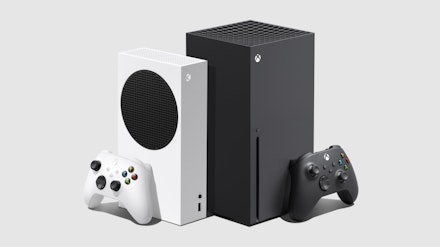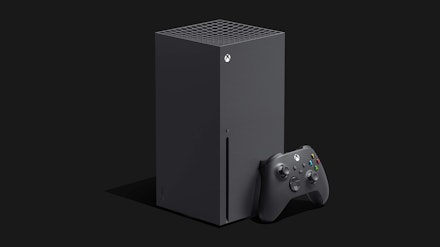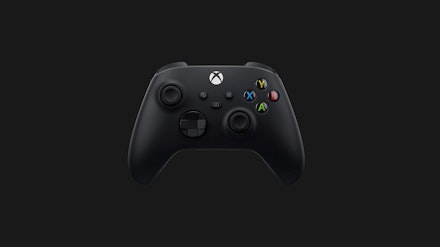It's telling that Microsoft's new flagship console doesn't have a name. Or rather it does: Xbox. Just Xbox. Gone are the days of numerical suffixes, replaced by a single platform with a single name. It's especially appropriate as Microsoft's new console doesn't really feel like a new console at all.
When the Xbox One X was releases in 2017 it, like the PlayStation Pro, marked a shift in console strategy: a mid-cycle hardware upgrade that materially improved the gaming experience without changing the platform. While the new Xbox is a significantly bigger step up than One to One X, it still feels more like an upgrade to the existing hardware rather than a whole new console. Albeit a fairly hefty one.

While sticking to simplified nomenclature, the new Xbox comes in two distinct flavours. The rectangular, snow-white Series S has no optical drive and lesser hardware under the bonnet but retails for a highly competetive £250. The Series X, meanwhile, will set you back a cool £450 but offers a whole lot of bang for those extra bucks.
The X is a squat, black, cuboid powerhouse that can either stand upright or on its side depending on preference. It's worth noting that the 'top' of the device (accented with a pleasing green vent) chugs a surprising volume of surprisingly hot air while in use, so needs a decent amount of clearance when laid on its side. The functional aesthetic won't be to everyone's tastes but there's a whole lot more going on with the X than its unorthodox form factor.
The console packs an 8 core Custom Zen 2 processor clocked at 3.8 Ghz, which means absolutely nothing to most people. In reality, the console is more than twice as powerful as the Xbox One X, allowing games to run silky smooth at 4K resolution, while maintaining frame rates anywhere from 60-120 FPS. If you have a 4K TV over 55 inches then the difference is immediate, for the first time feeling like we're really closing the gap between console and high end PC gaming, which remains the domain of those with a spare £2-3 grand to drop.

If you've a smaller or less capable display then the boost is less obvious, but the X offers signifcant quality of life improvements over and above graphical fidelity. The first thing you'll notice is the noise, or rather the complete lack thereof. The One X regularly took on the audio aspect of a jet engine when under load but even playing demanding titles, the Series X rarely emits more than a whisper.
More striing is the console's immediacy. Eschewing a hard drive storage in favour of a 1TB SSD, the X makes maximum use of the super fast solid state drive to cut loading times significantly. Games that used to take a minute or so to load, now fly up in a fraction of the time. You can also flip seamlessly between games with little down time and the quick resume lets you pick up almost exactly where you left off without having to navigate the menu (in most games, at least).
The benefits of the various hardware improvements are hard to overstate.
The benefits of the various hardware improvements are hard to overstate and, from a technical perspective, the Series X earns its title as the most powerful console currently available. What it isn't, however, is exciting. The controller is, save an improved D-pad, grippy triggers, a share button and enhanced haptics, basically the same Xbox controller you've been holding in your sweaty hands since the days of the 360. Meanwhile the UI remains unchanged from the Xbox One, contributing to the feeling that the new console, while a significant increase in raw power, is just a souped-up version of the machine we already know and love.
And then there are the games. Or rather the lack thereof. The new Xbox launches alongside a grand total of zero exclusive titles, which is a bold move for a piece of hardware that costs nearly five hundred quid. Every game released for the new Xbox at or around launch will also be available on the Xbox One, which means there's significantly less incentive to upgrade unless you're desperate to play the titles with the greatest level of detail.

However, the flip side to that is that the Xbox Series X{:rel=nofollow}and S will play basically all Xbox One titles without so much as a hitch and, in many cases, with enhanced textures, resolution and performance. This commitment to ongoing compatibility is to be celebrated and for those with significant game libraries already, an aspect that makes the new model more rather than less appealing.
It's also worth noting that for those without an extensive back catalogue, Microsoft's Game Pass represents extraordinary value for money. For £7.99 a month you can your hands on over 100 titles with more, often brand new, titles popping up all the time. All of which will help to keep players going until the big exclusives, like the delayed Halo Infinite, make their appearance and really show what this hardware can do. Until that day, though, the Series X remains an undeniably impressive, supercharged games console that doesn't feel quite as essential as we might have hoped.
Buy the Xbox Series X from Amazon.{:rel=nofollow}
